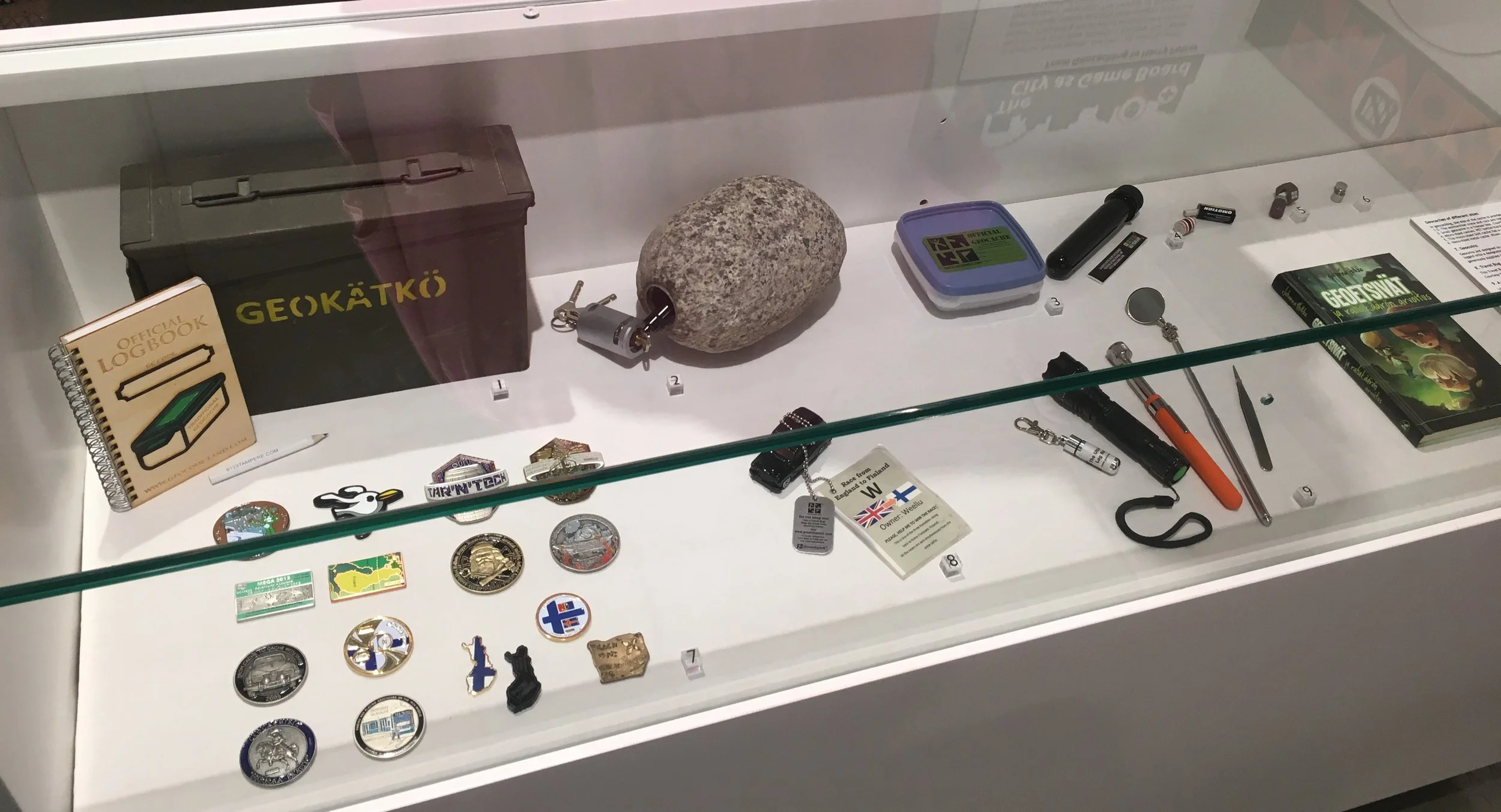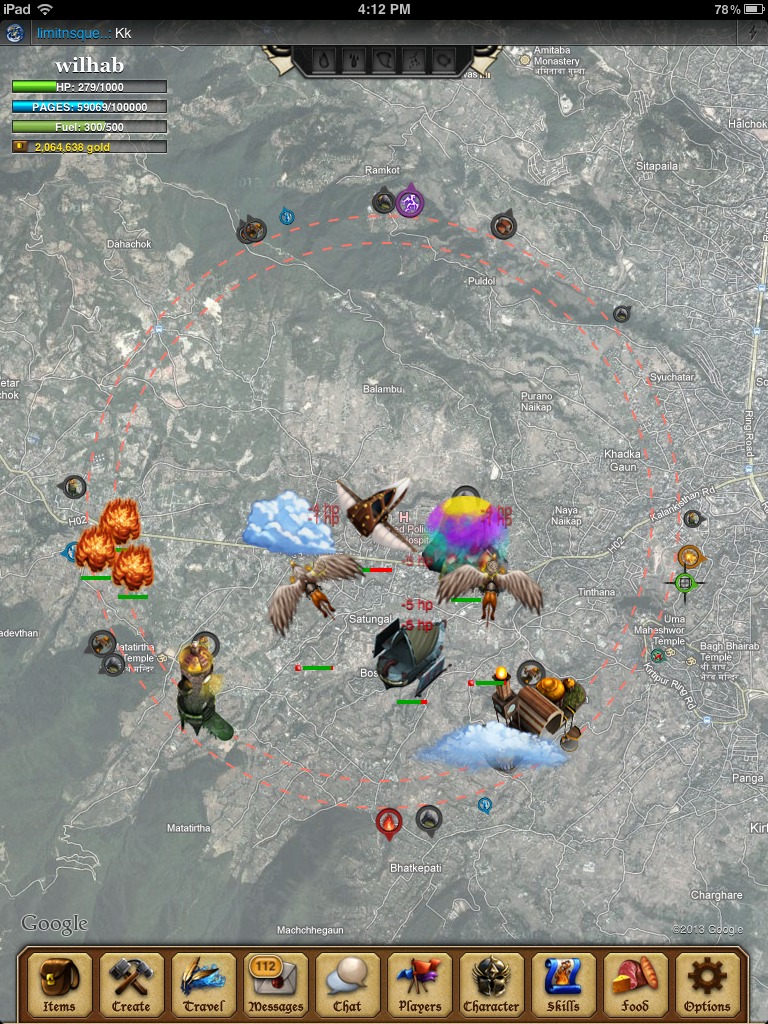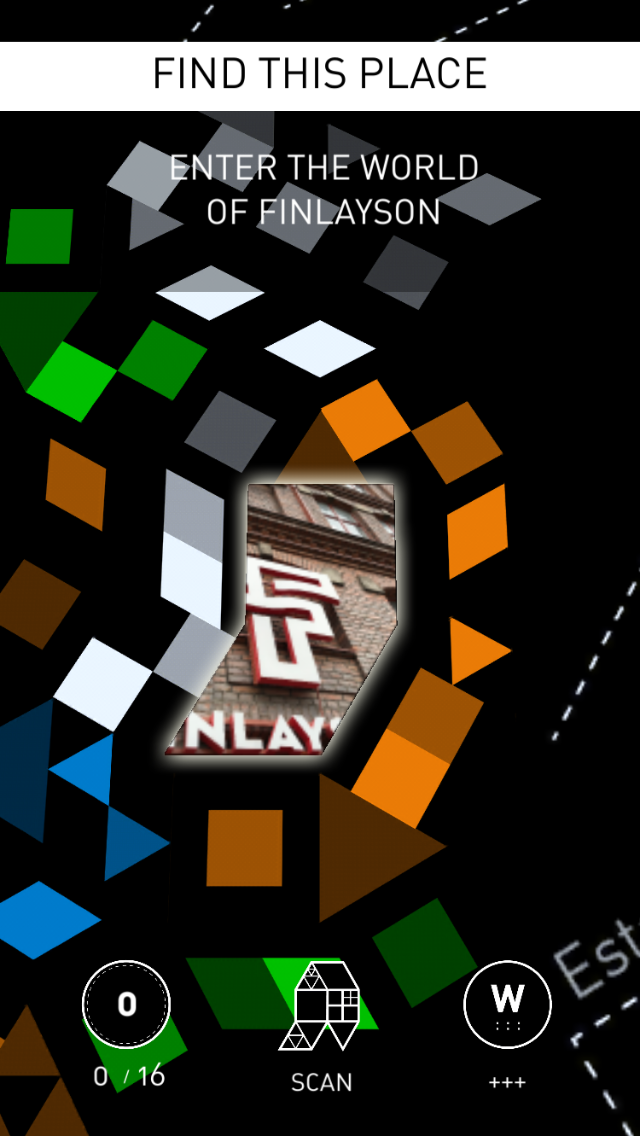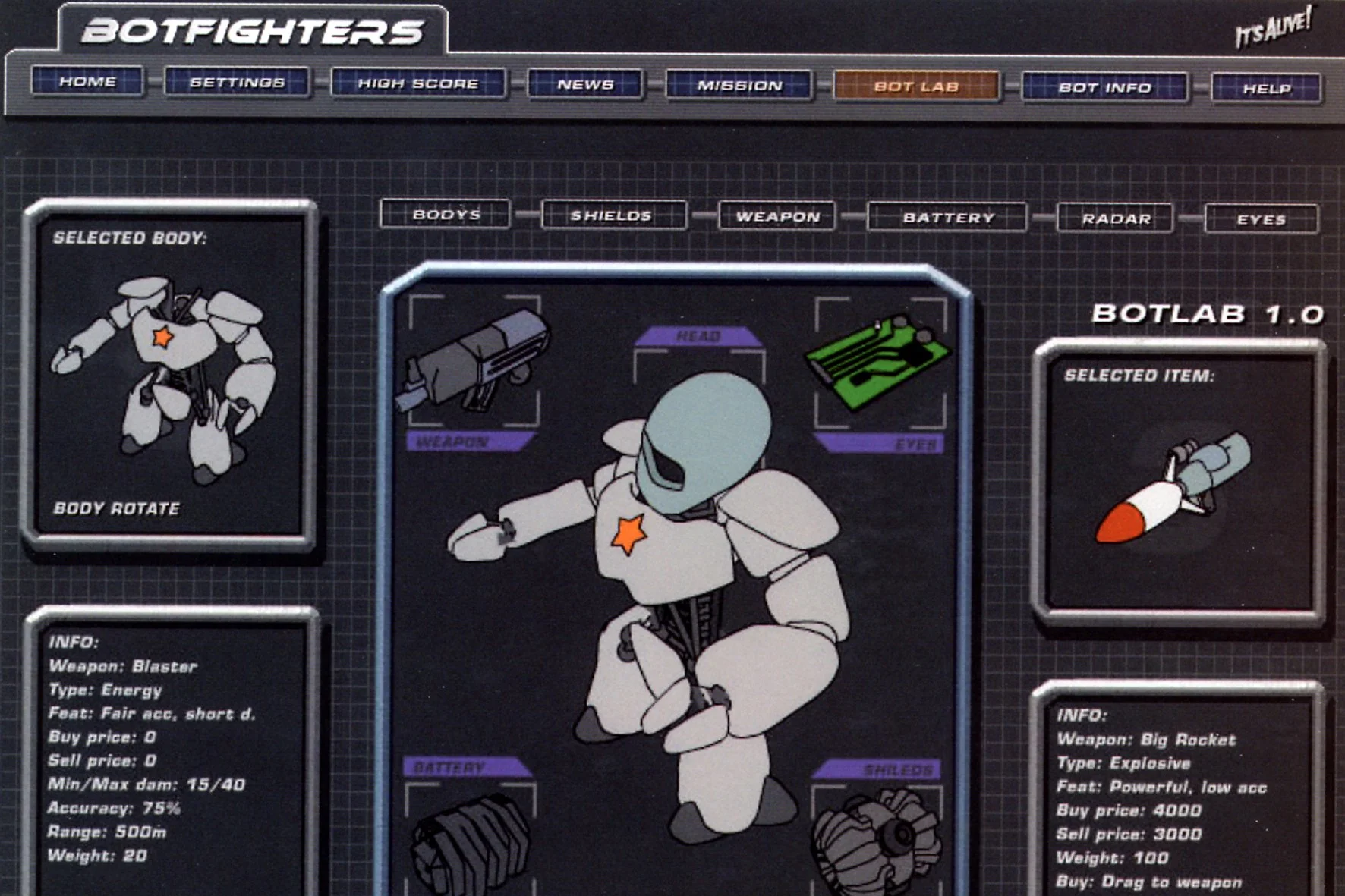The Games
Introduction
In location-based games, the city - its streets, architecture and everyday objects - become the “game board”. They bring the physical environment into the game through mobile and GPS technologies that track their players’ locations. The release of Pokémon GO in 2016 launched location-based games into the mainstream. But these games have a much longer history, dating back to early artistic and commercial experiments from the early 2000s onwards. This exhibition showcases this broader history, from the invention of geocaching to the first experimental games like Can You See Me Now? and Pac-Manhattan, and finally their eventual mainstream success through smartphone apps like Parallel Kingdom, Pokémon GO and, most recently, Harry Potter: Wizards Unite.
Curation and exhibition text © Dale Leorke. Full credits here.
1. Emergence
Location-based games emerged after precise GPS (Global Positioning System) data was made available for civilian use by the U.S. government in May 2000. Artists, amateurs and game designers began to experiment with a combination of mobile phones, GPS trackers and custom-made devices to take gaming out into the streets. This section highlights three important games and practices from this early, experimental period of location-based gaming.
Geocaching (2000)
Dave Ulmer
Photos by KennethHan and Tatu Kosonen.
On 1st May 2000, two days after the U.S. government made pinpoint GPS data publicly available, computer consultant Dave Ulmer proposed a playful way to test its accuracy. He partially buried a stash of items in the woods near Beaver Creek, Oregon, and posted its GPS coordinates - N 45° 17.460 W 122° 24.800 - online. He invited people to track the cache down, calling it The Great American GPS Stash Hunt.
In September 2000, GPS Stash Hunt was rebranded as geocaching when Seattle-based web developer Jeremy Irish launched geocaching.com. The website allows users to share their own caches and mark off ones they’ve found. Caches might contain a logbook for players to sign, trinkets that can be traded, and trackable items - like geocoins - that move from one geocache to another. Today, geocaching continues as both a hobby and business, generating revenue through merchandising and smartphone apps while attracting devoted followers.
Top row, left to right: Geocache crates of different sizes: ammunition crate, rock, freezer box, and micro and nano-sized crates (courtesy Veli-Pekka Eloranta & Kiven alla Oy).
Bottom row, far left: Geocoin collection (courtesy Pekka Hautala)
Bottom row, centre left: Travel bug (courtesy Veli-Pekka Eloranta)
Bottom row, centre right: A geocacher’s tools (courtesy Veli-Pekka Eloranta)
Bottom row, far right: Johanna Hulkko’s book Geodetectives and the mystery of the bundle of cash (2013).
Can You See Me Now? (2001)
Blast Theory & Mixed Reality Lab (University of Nottingham)
Can You See Me Now? is one of the first location-based games. Designed by UK artistic group Blast Theory and University of Nottingham researchers, it pits online players against “runners” in the city streets in a real-time game of hide and seek.
Members of Blast Theory are the runners, who are tracked by GPS devices as they navigate the city streets. Public participants are the online players, who can see the runners’ real-world location on an interactive map and control a digital avatar to avoid being “caught” by them. This blending of physical and virtual space was pioneering at the time, and the game won the prestigious Prix Ars Electronica award in 2003. It has been performed in various cities including Sheffield, Rotterdam, Brighton, Barcelona and Tokyo.
Pac-Manhattan (2004)
Frank Lantz & NYU students
Photos at top by Ehud Kenan.
New York Times article and game maps courtesy Pete Vigeant.
Pac-Manhattan was designed by students of academic and game designer Frank Lantz’s “Big Games” course at New York University. One player is dressed as Pac-Man, who is chased by four ghosts (Inky, Blinky, Pinky and Clyde). Instead of an arcade or computer screen, the game uses the Washington Square Park area of New York’s city grid as the game space. The game was low-tech: each player spoke with another human “controller” over a mobile phone, updating them about their location by voice rather than through GPS. This meant there were 10 players - 5 on the street and 5 in the control room. The game became a small phenomenon, with players taking its “source code” and adapting it for over 30 cities worldwide.
2. Commercialisation
Location-based game designers have tried many different business models to make their games profitable and popular, from monthly subscription services with mobile service providers to free-to-play apps with optional in-game transactions. Just like other videogames, location-based games have achieved varying degrees of commercial success.
Mogi, Item Hunt (2003)
Mathieu Castelli / Newt Games
Photo of Mogi web client (left) by Paul Baron.
Mogi, Item Hunt was available across Japan between 2003 and 2008, reaching over 1000 simultaneous active players at its peak. Subscribers to mobile service provider KDDI’s unlimited data package could access the game on their mobile phones. This made it more easily accessible than many previous, more experimental location-based games. It is one of the longest-running and most commercially successful location-based games before the release of the iPhone 3G in 2008.
Mogi allowed players to hunt, collect and trade virtual items - creatures, fruits, gems, etc - by travelling to their GPS location using a 2D “radar” interface on their phones. Although players could not see each other on the map, the game encouraged social interaction through an online chat feature and the ability to swap items, which awarded points when completing item collections of the same type.
Parallel Kingdom: Age of Ascension (2008)
PerBlue Entertainment
In June 2008, Apple released the iPhone 3G along with its App Store service. This combination of built-in 3G connectivity and the app distribution model meant location-based game designers could now reach a global audience through a single platform.
Parallel Kingdom: Age of Ascension was one of the first location-based games for iOS and Android. It was designed by Wisconsin-based start-up PerBlue Entertainment and made a profit through in-game transactions. It was a fantasy-themed massively multiplayer online game where players built cities, battled monsters, and collected resources in their own neighbourhood. The game spawned two sequels in 2012, Parallel Mafia and Parallel Zombies. It remained live until 2016 when its servers were eventually closed down.
It Came from a B-Movie (2015)
Jaakko Kemppainen / Triple Sec Entertainment
In this Finnish-designed game, players fought together against monsters like zombies, UFOs, and cursed gardening tractors across the game map. Meanwhile, “epic” monsters like Godzilla or King Kong appeared rarely in selected locations and required hundreds of players fighting for days to defeat them. If players couldn’t physically travel to these specific locations, they paid to hire a “stuntman” to virtually fight monsters across the globe.
Despite its original and inventive ideas, the game’s development was hampered by bad luck and difficulty attracting funding. It was released on Windows Phone in early 2015 and removed several months later. It’s an example of how location-based game developers struggle to realise their ideas and make them successful, especially before the breakout success of Pokémon GO.
3. Present & Future
When Pokémon GO was released in July 2016, location-based gaming reached new heights of popularity and commercial success. This success reinvigorated interest in location-based games - from both commercial developers and artists creating small-scale, city-funded games. This section highlights two recent games influencing the future of location-based game design.
Pokémon GO (2016)
Niantic, Inc.
Pokémon GO became a global phenomenon virtually overnight when it launched in July 2016. It was greeted by daily media reports about crowds of players swarming public places to catch rare Pokémon and incidents of trespassing, theft and vehicle accidents. Despite a drop in the number of active players from its heights in 2016, Pokémon GO remains one of the most successful and popular smartphone apps of all time with over 1 billion downloads and US$2.6 billion in revenue. New features and Pokémon continue to be added.
The game also gave rise to a surge of new location-based game apps based on successful movie and TV franchises, including The Walking Dead: Our World, Jurassic World Alive and Ghostbusters World in 2018 and Niantic’s own Harry Potter: Wizards Unite in June 2019.
Wayfinder Live (2016)
Troy Innocent
Although smartphones allowed location-based games to be more commercially successful than ever before, they also created new possibilities for artistic experimentation. In Wayfinder Live by Australian artist-academic Troy Innocent, players download a free smartphone app which provides clues to track down 16 physical codes around the city. The codes are usually hidden in out-of-the-way locations and are designed to blend in with their surroundings.
When players find a code, they scan it through the app to unlock an augmented reality animation and receive influence points, which they can spend to “control” that code for their chosen faction. The game has been performed in cities around the world, including Aarhus, Barcelona, Bristol, Dublin, Melbourne, Singapore and Taipei.
Bonus
There were several games I had originally intended to include in the exhibition but was unable to, due to space constraints and lack of available materials for them. I include them here as “bonus content” for this “virtual” version of the exhibition.
Botfighters (2001)
It’s Alive!
Alongside Can You See Me Now?, Botfighters was one of the first mobile games to experiment with GPS technology. Players logged into a website and created a robot avatar, equipping it with weapons and shields. They then downloaded this avatar to their mobile phone to use in battles with nearby players. These battles were conducted by sending text message commands to scan, locate and “shoot” players within a 500-metre radius. Attacks were stronger at closer ranges, so the game encouraged players to either move closer to their opponent or run away from them, depending on their health. Killing an opponent awarded the victor “robucks” that they could spend on the game website to upgrade their avatar.
Botfighters launched in Sweden before being rolled out in China, Finland, Ireland, Russia, Turkey, and the UK. It was a commercial game and the developers took a percentage of the revenue from each text message - an earlier version of today’s microtransaction model. Some players reportedly racked up bills of hundreds of dollars each month.
The Songs of the North (Pohjoisen laulut) (2003)
University of Tampere GameLab
This game was an early prototype developed by researchers at Tampere University, Finland. Drawing on Nordic mythology and Kalevala stories and poetry, players are shamans inhabiting a spirit world who must collect scattered pieces of a powerful magic machine. The game map and interface were depicted as a drum played using the phone’s numerical keys. Players were also presented with quests that required them to cooperate with other players and move through the physical environment (within a 10km radius of the University) to complete. Two separate playtests with students were run over several weeks in the summers of 2003 and 2004, but the game was not developed further.
Shadow Cities (2011)
Grey Area
Shadow Cities was a a fantasy-themed online multiplayer game created by Finnish startup Grey Area. It attracted international attention, including a review by The New York Times describing it as “the future of mobile gaming.”
Players began by choosing between two warring factions competing for control over territory. Players claimed territory for their faction by destroying other players’ “dominators” and placing and defending their own. They levelled up by tracing “runes” on the phone screen to cast spells to attack other players and roaming NPC spirits (represented as orbs on the game map). Players had to physically move with their device to move their avatar, but could “warp” to locations anywhere in the world where registered friends from their faction had set up “beacons.”
Shadow Cities made a profit through micro-transactions and was briefly successful, but struggled to retain players. Grey Area closed the game’s servers in 2013 to focus on a second location-based game, Tank Legions, but this was unsuccessful. After releasing two more unsuccessful games, the company disbanded. Several of its employees moved to Next Games, which released The Walking Dead: Our World location-based game in 2018; while two of Grey Area’s founders have since founded Shipyard Games, which to date has released two short-lived location-based games.
Harry Potter: Wizards Unite (2019)
Niantic, Inc.
In mid-2019 Niantic released its much-anticipated and -hyped follow-up to Pokémon GO, based on an even more globally-recognised franchise: J.K. Rowling’s Harry Potter series. The game was more narrative-driven than Pokémon GO, with voice acting and a storyline that expanded over time. Players were members of a secret task force working together to locate displaced “Foundables” and return them to their rightful place and time. Players cast spells by tracing lines on their phone screen and could customise their character to become an Aurora, Professor, or Magizoologist.
Despite the hype and momentum behind it, Wizards Unite failed to attract even a fraction of Pokémon GO’s fanbase or appeal to most Harry Potter fans. Its servers were closed in January 2022, just 2.5 years after its release, even as Pokémon GO continued to attract new features and remain enormously profitable.
Like many games in this exhibition, Wizards Unite highlights the enormous difficulty in making location-based games commercially successful and sustainable long-term, whether they are based on globally-recognised franchises, or original and innovative concepts like Shadow Cities. Niantic have since released Catan: World Explorers (2020), Pikmin Bloom (2021) and Peridot (2022), but neither they nor other studios have yet managed to replicate Pokémon GO’s success.
All images on this webpage copyright of the relevant artists/designers or Dale Leorke unless otherwise stated.



































